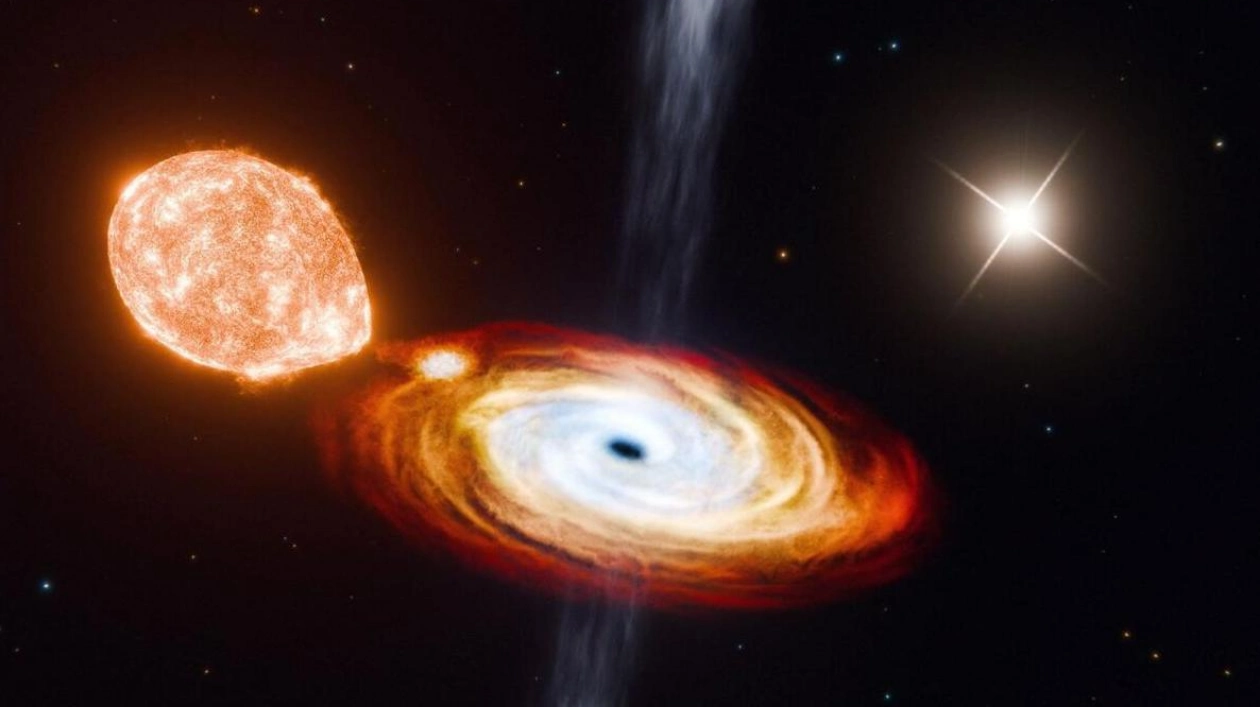An artist's impression depicts a triple star system known as V404 Cygni, featuring a black hole and two ordinary stars. The image shows material being siphoned from the deformed nearby star (left) as it swirls around the black hole (right), while the third star (top right) shines in the distance. — Reuters
Conventional wisdom among astronomers posits that black holes—those extraordinarily dense objects with gravity so intense that not even light can escape—arise from the violent explosion, known as a supernova, of a massive dying star. However, some black holes may form in a more subdued manner. Researchers have identified a black hole that seems to have originated from the core collapse of a large star in its final moments, without the customary blast. This black hole is gravitationally bound to two ordinary stars.
Previously, black holes have been observed orbiting with one other star or one other black hole in binary systems. This marks the first known instance of a triple system comprising a black hole and two stars. This system is situated approximately 7,800 light-years from Earth in the constellation Cygnus. A light-year measures the distance light travels in a year, equivalent to 5.9 trillion miles (9.5 trillion km).
The black hole, named V404 Cygni, has been the subject of extensive study since its confirmation in 1992. Initially believed to be orbiting with only one other star, data from the European Space Agency's Gaia space observatory revealed it has two companions. The researchers estimate that the black hole, with a mass nine times greater than our sun, is in the process of consuming one of its companions, a star with about seven-tenths the mass of the sun. This star orbits the black hole every 6-1/2 days at a distance roughly one-seventh that separating Earth and the sun.
The black hole appears to be siphoning material from this star, which had expanded into a red giant phase during its natural aging process. Another star, approximately 1.2 times as massive as the sun, is gravitationally bound to these two but is quite distant, orbiting them every 70,000 years at a distance 3,500 times greater than that separating Earth and the sun.
The researchers hypothesize a gentle formation process for the black hole because the triple system would have disintegrated if the star that became a black hole had exploded. A black hole typically forms when a large star exhausts its nuclear fuel and collapses inward due to its gravitational pull, triggering a massive explosion that ejects its outer layers into space. The resulting crushed core forms the black hole. However, some astronomers propose an alternative path called 'direct collapse,' where the star implodes after using up all its fuel without exploding.
Massachusetts Institute of Technology astronomer Kevin Burdge, the lead author of the study published in the journal Nature, described these events as 'failed supernovae.' He explained that the gravitational collapse occurs too rapidly for a supernova to trigger, resulting in an implosion rather than an explosion. The researchers estimate that the members of this triple system initially formed about 4 billion years ago as ordinary stars.
Caltech astronomer and study co-author Kareem El-Badry added that the triple system could not have survived if the black hole had been born with a natal kick, implying a quiet implosion rather than an explosive supernova. This system will not remain a triple forever, as the black hole is consuming its closer neighbor. This suggests that some known binary systems with a black hole and an ordinary star may have originally formed as a triple system, with the black hole eventually consuming one of its partners.
El-Badry noted that while black hole binaries were predicted to form mostly through triple evolution, there was never direct evidence until now.
Source link: https://www.khaleejtimes.com






